We Tested 13 Kitchen Scales to Find the Best Ones
Dotdash Meredith and Yahoo Inc. may earn commission or revenue on some items through the links below.
Our top picks are the OXO Good Grips Stainless Steel Food Scale and Escali Primo Digital Scale.
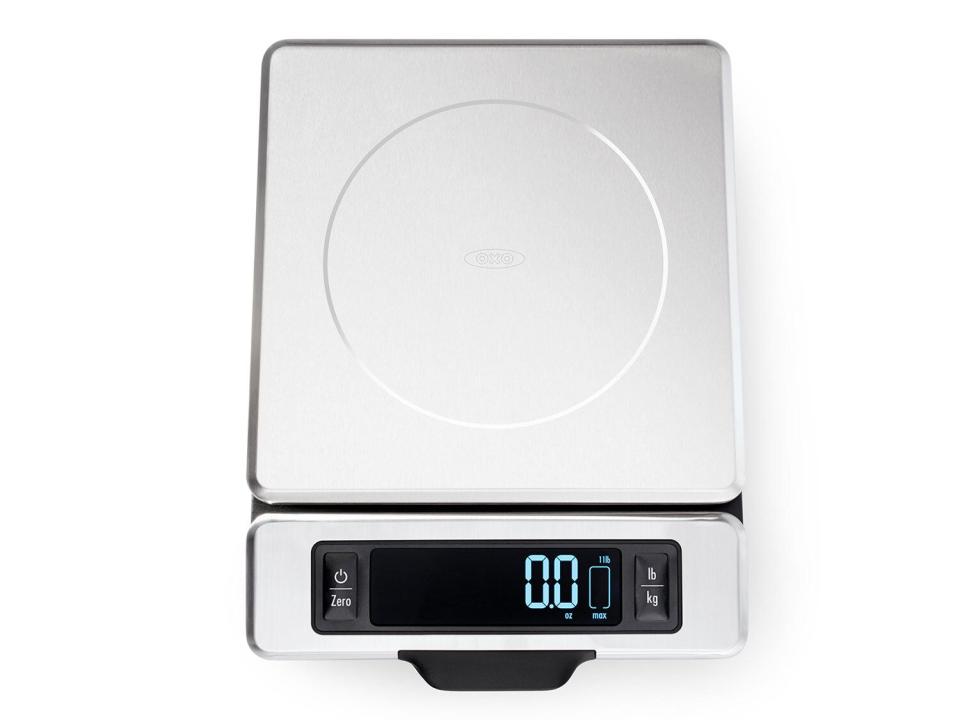
Serious Eats / Emily Dryden
Our favorite kitchen scale is the OXO Good Grips Stainless Steel Food Scale, which is incredibly accurate and functional, with added features like a pull-out display and removable scale bed. We also like Escali Primo Digital Scale. It's minimalist, accurate, and budget-friendly.
A good kitchen scale is an absolute must-have for every kitchen. Although nothing can substitute for skilled intuition—add a dash of this and a handful of that, cook until golden brown and delicious—there are times when the precision a scale can provide is vital. Many baking recipes call for cups and fluid ounces, but no matter how experienced a baker you are, the cup of flour you weigh today will not be the same cup of flour you weigh tomorrow. This is because many dry ingredients, such as flour, cornstarch, and brown sugar, can easily be compressed or aerated depending on the whims of the measurer, how the goods have been stored, and possibly some black magic.
Scales aren't just for all the would-be pastry wizards out there, either. They're a necessary tool for any serious cook as well, especially for determining ratios or servings. If you like your mirepoix to be two parts onion to one part celery and carrot, a quick check on the scale can guide you. More advanced recipes—such as those for charcuterie, in which perfect proportions of fat to meat to salt are everything—demand the use of a scale. Even in your day-to-day life, brewing coffee is made much easier with a scale, allowing you to forget scoops of beans and cups of water and just measure it all in grams.
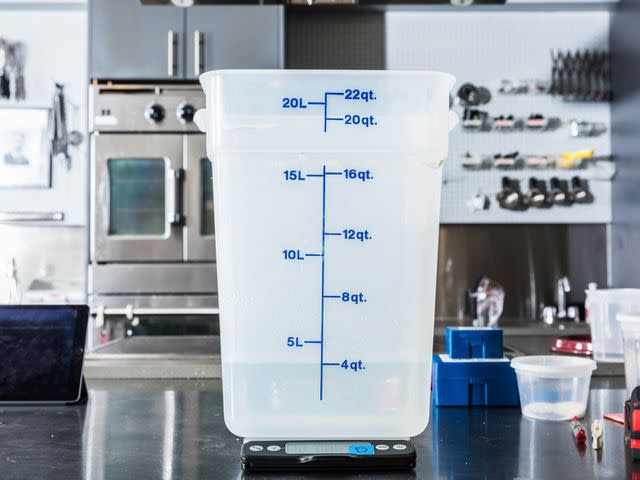
Serious Eats / Emily Dryden
If you do decide to purchase a scale, the variety on the market today can make picking one a daunting task. We've set out to determine which scale is the best for all your kitchen needs by testing 13 models, ranging in price from $9.99 to $59.99, with maximum capacities between 11 and 17.6 pounds and resolution between 0.05 and 0.1 ounces. Although we wouldn't recommend using a kitchen scale to weigh anything under five grams (a jeweler's scale is the way to go for smaller amounts), a scale with higher resolution will be more responsive to minute, incremental changes in weight.
A great scale should be accurate first and foremost, but also easy to clean, intuitively designed, simple to read, and convenient to store. These are the qualities that will have you reaching for a scale every time you portion meat for burgers or whip up a batch of fresh pasta.
The Winners, at a Glance
The Best Kitchen Scale: OXO Good Grips Stainless Steel Food Scale

Consistently accurate, with a functional design and practical extras, this OXO Stainless Steel Scale came out on top again and again in every round of testing. Our winning scale went above and beyond as the only one to feature a pull-out display, battery-life and maximum-weight indicators, and the longest delay before the scale shuts off automatically. Its slim design makes it easy to fit it into any drawer, though it's still heavy and stable during use. In 2021, OXO released a newer model that we’ve tested and think is an improvement on the original. While there are some small design changes, what we love about the scale still exists: the removable scale bed for easy cleaning and the pull-out display for when you’re weighing a large vessel. What’s more, the newer scale now remembers which unit you’ve been using, so you don’t need to reset it after each power-up. Finally, the blue backlight has been removed and replaced with a digital display where the background is black and the measurements are in white, so it’s always illuminated no matter the amount of light in your kitchen.
The Best Budget Kitchen Scale: Escali Primo Digital Food Scale

The Escali may not have all the trimmings of the OXO scale, but at half the price, this durable yet lightweight scale is an excellent kitchen workhorse. It has a minimalist design, with simple buttons and an easy-to-read display. We found it to be accurate to the gram, with near-instantaneous readings and a long delay before auto shutoff.
The Criteria: What We Look for in a Great Kitchen Scale
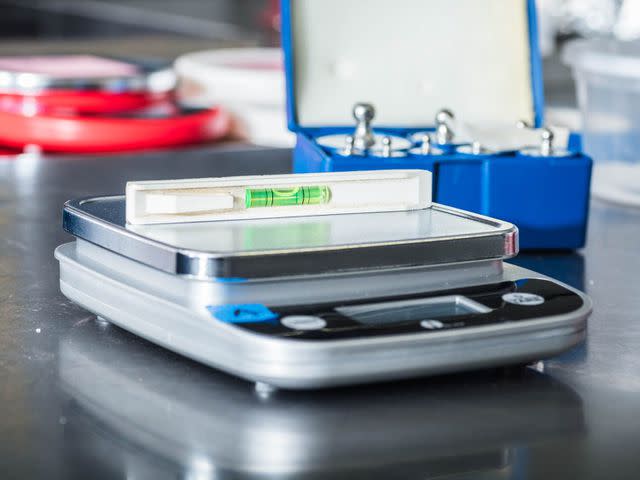
Serious Eats / Emily Dryden
There are countless kitchen scales on the market today. We found scales that slide out of the side of a cutting board, scales that fold up Transformer-style to fit into a pocket—even scales that make health claims, like "Lose 10 pounds in one week by weighing what you eat!" It was an ocean to wade through, so we had to set strict rules for ourselves to determine what qualities were most important for the home cook.
We limited our test to scales that had a maximum capacity of no less than 11 pounds. A six- or eight-pound capacity might sound like plenty, but once you've taken into account the weight of the vessel you're weighing your ingredients into, you can quickly begin to...tip the scales. Especially because many cooks weigh into glass bowls or saucepots, a minimum capacity of 11 pounds is a necessary requirement.
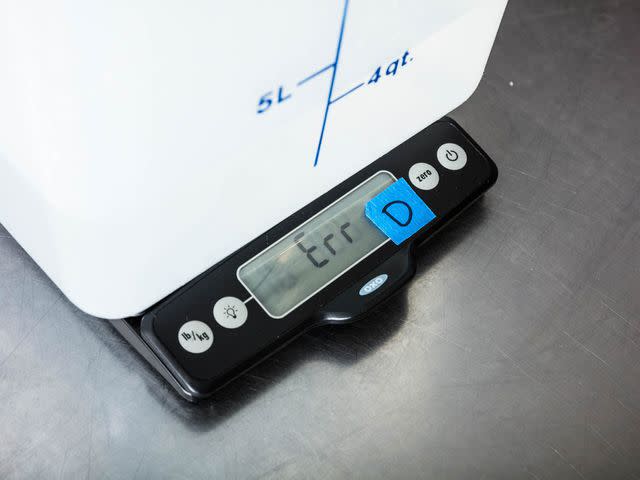
Serious Eats / Emily Dryden
Scales that displayed weights in fluid ounces and milliliters were also immediately ruled out. Significant confusion already exists between ounces (a unit of mass) and fluid ounces (a unit of volume), and we felt that a scale displaying these fluid units would only aggravate the problem. Although one fluid ounce of water equals roughly one ounce of water (1.04 ounces, to be precise), liquids can vary greatly in density. Believing you can use a scale to weigh six fluid ounces of honey or molasses is a mistake that could decidedly derail a dessert. We tested only models that display weights in units of mass—grams and ounces—not volume.
We also looked for scales with reasonably sized platforms, ones that are large enough to easily fit a mixing bowl or bag of onions, but not so big that storage of the scale would become an issue. For us, this meant scales with platforms ranging in size from five and a half inches to 12 inches across in length.
We tested only scales that included a tare function in the design. Pushing the tare button resets the scale to zero, allowing you to weigh different ingredients in the same vessel without having to do any math.
Easy cleanup is key in the kitchen, where there are so many opportunities for messes. Many kitchen scales have raised buttons or displays with unsealed edges, increasing the potential to quickly muck them up with flour and oil, so they become impossible to clean. We gave preference to models with sealed buttons and fewer crevices for food to get trapped inside.
The Testing
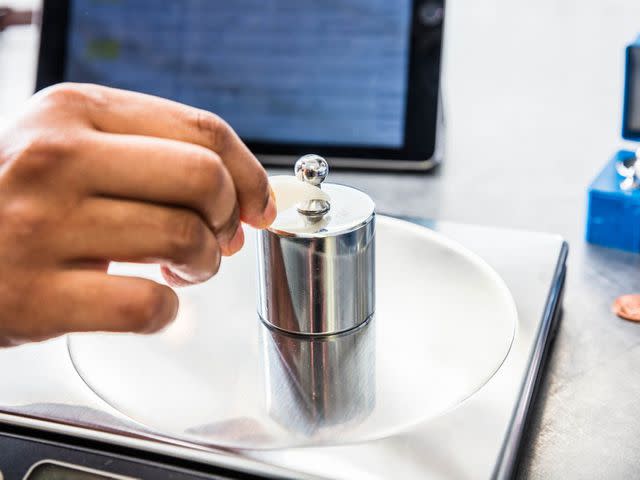
Serious Eats / Emily Dryden
Test 1: Accuracy
To determine accuracy, we tested each scale with calibrated five-gram, 10-gram, 100-gram, and 500-gram weights. The weights were tested multiple times on the centers of the scales as well as each corner, to ensure that accuracy wasn't dependent on where the weight was placed on the platform. The majority of the scales were consistently accurate; only four displayed inaccuracies of between one and three grams.
We also wanted to test whether that fine-tuned accuracy degraded when the scale was loaded with heavier stuff—for example, if you were whipping up a batch of Kenji's pizza dough and wanted to weigh sugar into the bowl you'd already scaled the flour into. To test this, we set a 750-gram calibration weight on each scale, then added the lighter calibration weights on top of that. We found that some scales displayed greater inaccuracies with this test; the worst performer was off by seven grams.
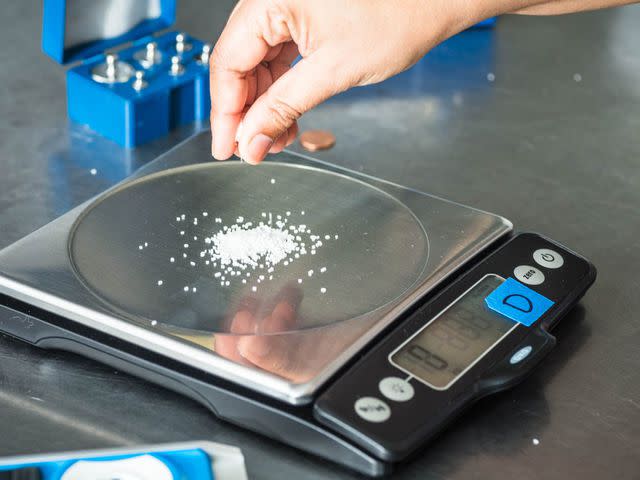
Serious Eats / Emily Dryden
Although most kitchen scales aren't designed to weigh minuscule quantities of ingredients, such as a teaspoon of salt or baking powder (Stella has written about this in depth), we decided to run a test to see if any of the scales could handle it, the assumption being that if a scale could accurately weigh a small amount, it would likely be more adept at measuring a pound of sugar. To test how accurate the scales were with very small amounts, we attempted to weigh a penny, which weighs 2.5 grams, on each one. Some scales read the penny as two grams, others three, while a couple of scales didn't register the weight of the penny at all.
Read More:We Tested 24 Liquid Measuring Cups to Find the Best Ones
Finally, we tested each scale's accuracy at measuring small amounts incrementally. We weighed 40 grams of salt, one pinch at a time, to see if the scales could accurately measure it. While most performed well, a few were off by as much as 20 grams, and one scale could not even complete the test, repeatedly timing out before all the salt was measured.
Our top picks not only performed well on all these tests, but were also capable of accurately weighing as little as two grams, which is far more accurate than you need for most tasks.
Test 2: Ease of Use
Time to Turn On
We timed how many seconds it took for each scale to turn on. One scale took almost five seconds to fire up, while others were instantaneous. Our winners fell in the middle, with the OXO taking three and a half seconds and the Escali two seconds. Most of the scales took about two and a half seconds to activate.
Time to Auto Shutoff
It makes sense for a scale to shut itself off to conserve battery life after a period of inactivity, but it can be exasperating when it's programmed to do it too soon. A scale turning itself off while you're mid-recipe, just because you stepped away to get another bag of flour or stick of butter, is enough to make you throw it against the wall. Even worse is one that has no memory function and resets to zero after shutting down on its own.
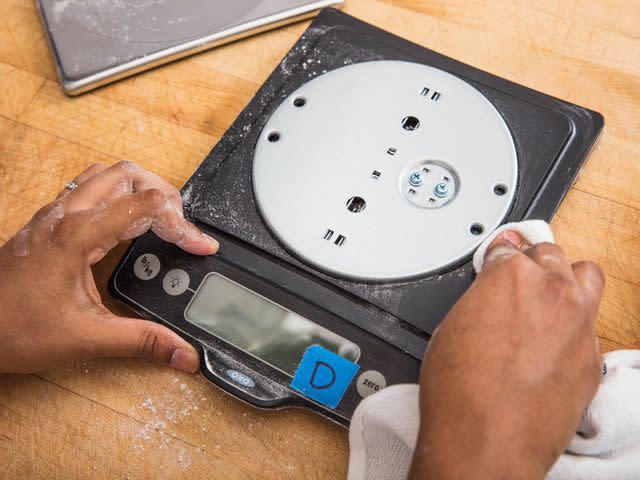
Serious Eats / Emily Dryden
It was important for us to pick a winner with both a reasonable wait time before the auto shutoff and the ability to remember the weight of whatever is on the scale when it's turned back on. Some of the scales' auto shutoff would kick in, annoyingly, after just one minute, while our top pick lasted the longest, at six minutes.
Interface: Buttons and Display Options
For a tool you want to reach for over and over again, a user-friendly interface and intuitive design were imperative. Most of the scales were very similar in the design of their buttons and display. The on/off switch typically doubled as the tare button when held down for a moment versus quickly tapped, and the second button switched between metric and customary units.
A few scales took a more inventive approach with button placement, much to our testers' confusion. The button most often used is the tare function, but one scale had it placed so close to the on/off button that we often ended up accidentally turning off the scale. Though switching between metric and customary should be a similarly simple and accessible function, some scales required the use of a toggle switch beneath the unit, or even hidden inside it.
Visibility
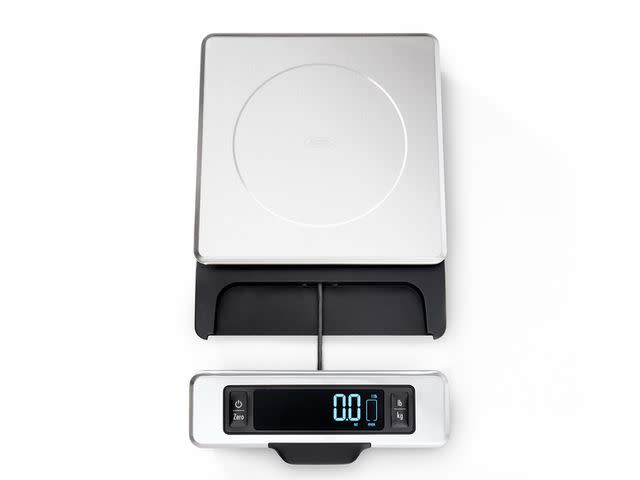
Serious Eats / Emily Dryden
It was important for us to find scales with displays that were easy to read, so we looked for either high contrast or backlit displays with clear fonts. But large, easy-to-read lettering and a vibrant backlit display are useless if you can't see the display under a large bowl. Often, wide bowls or pots make it impossible to read a scale, so we measured the distance from the center of each scale's weighing platform to the center of its display. Scales with more distance between the two ranked higher in our testing.
Several scales measured as little as three inches between the platform center and the display. This short distance, coupled with a low-profile design, made it extremely difficult to read the display with even a small mixing bowl on top. Our best performer had a pull-out display that extended the distance to a full eight inches, allowing the tester to easily weigh ingredients into wide mixing bowls and large pots without ever struggling to read the results.
Cleanup
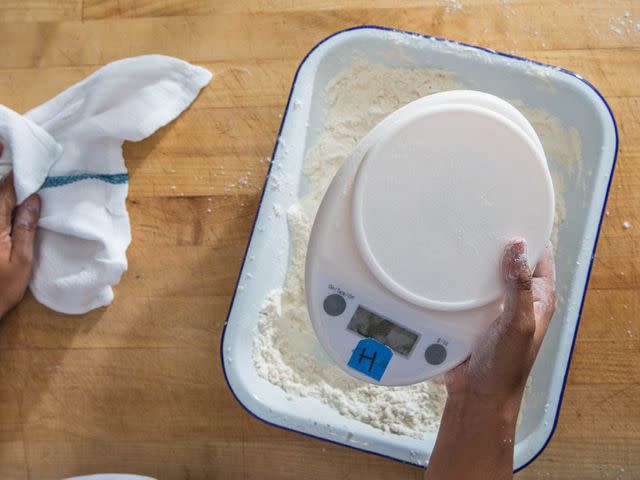
Serious Eats / Emily Dryden
To test how easy each scale was to clean, we buried it in flour, then took note of how readily it wiped clean with a towel. Unless you're cooking in a dust bowl, your scale will never encounter this volume of dirt, but it gave us a good understanding of which models had an inordinate number of nooks and crannies for grime to build up in. Some scales had removable plates, allowing you to wipe away any flour that snuck underneath.
Stability
It was important to pick a stable scale, too—one that didn't annoyingly tip or slide around the counter every time you pressed a button. Many of the lightweight scales easily fell over and bounced around on the counter whenever we tried to press tare or change units; this was especially noticeable in ultra-slim models. It resulted in the reading fluctuating by between five and 10 grams every time, and the scale often not returning to the correct weight when it finally came to rest. The Escali Primo managed to successfully incorporate a lightweight design without suffering from this defect.
How We Chose Our Winners
The primary function of a scale is to consistently and accurately weigh ingredients, so inaccurate scales were immediately out of the running. Our winning scales were the most accurate, and also easy to clean and easy to use. They came in on top through all of our testing.
We preferred simple designs and displays, which minimize confusion. When you're working at the fast pace often required in a kitchen, trying to find the tare button on your scale is a frustrating waste of time. Our winners had the longest delays before auto shutoff as well, and stable designs that prevented the scales from moving at the mere press of a button.
The Best Kitchen Scale: OXO Good Grips Stainless Steel Food Scale

What we liked: Typically, when any product is advertised as having extra attachments or bonus features, they're cheap gimmicks that don't add much real value. With our winning scale, every extra feature has been developed with the cook in mind. The OXO offers the best display, with a backlit option and high-contrast indicators, and it was the only model we tested that has battery-life and maximum-weight indicators, saving you from the frustration of a dead scale mid-recipe or the risk of damaging the scale through accidental overloading. It also features a pull-out display that allows clear viewing even when wider receptacles are sitting on it.
With its removable stainless steel platform, the OXO was the easiest scale to clean of the bunch. One could weigh raw meat directly on the scale, then remove the platform to hand-wash for guaranteed sanitation. In the flour test, we were able to remove the platform to wipe out every last speck of flour.
The OXO scale had the longest delay before auto shutoff, at 30 minutes, though it goes into automatic sleep mode after six minutes. While in sleep mode, the scale retains memory of what you last weighed until the 30-minute auto-shutoff point. This was the only scale with memory, which proved to be incredibly useful when we were interrupted during cooking. With OXO’s newest 2021 model, you won’t need to adjust your unit of measure each time you turn the machine on if it's different from the default of pounds and ounces: It’ll remember what you previously used, which will save you from having to reset it constantly. What’s more, there are only two buttons now: the on/off button, which also is what you press to tare, and the unit conversion toggle.
The new 2021 model also offers more unit display options: you can see pounds and ounces, or just ounces (e.g.., 1 pound 2 ounces versus 18 ounces); and you can also see kilograms and grams, or just grams (3kg 15g versus 3015g). This can be helpful since recipes from various sources often have different unit conventions; without the help of the scale, the home cook may be left to do unit conversions themselves, which increases the risk of error.
What we didn't like: At two pounds, the OXO is one of the heavier scales we tested, a weight that can be cumbersome. The scale also had one of the slower start-up times (three seconds long). As we used the scale repeatedly throughout the day, this became bothersome. When we first tested this model, our biggest gripe was that it displayed ounces in fractions rather than decimals; luckily, OXO’s newer model eliminated fractions and uses a decimal-only format. We also had complained of a slight lag when dosing our a series of ingredients, but the newer model is speedier, registering new additions much more rapidly.
Price at time of publish: $56.
Key Specs
Units: Ounces, pounds, grams, kilograms
Max weight: 11 pounds
Dimensions: 9.5 x 7 x 1.25 inches
Features: Pullout display, battery life indicator, max weight indicator, auto shut-off
Tare: Zero/tare button
Warranty: 5 years
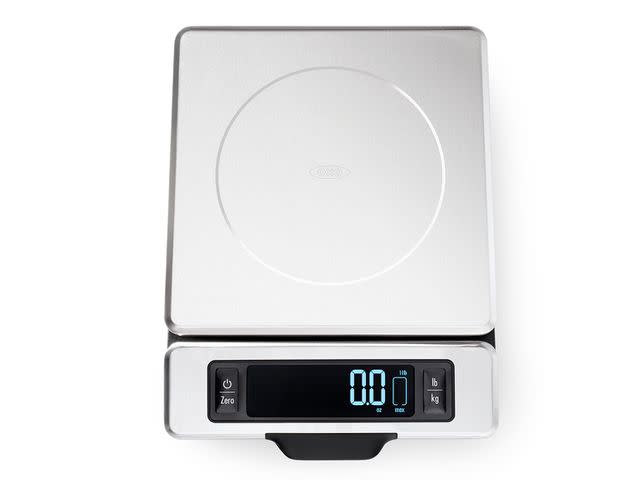
Serious Eats / Emily Dryden
The Best Budget Kitchen Scale: Escali Primo Digital Food Scale

What we liked: We loved the simple, lightweight design of the Escali Primo. At only 11 ounces, it's a snap to grab and always have by your side. Though light, it managed to be stable thanks to its skidproof rubber feet and square base. The basic display and interface are effortless to read and use. The scale features only two buttons: one to change units, and another doubling as the on/off button and tare function. Providing accurate measurement in both metric and customary units, it has all the basics.
The Escali Primo had the second-longest delay before auto shutoff, at four and a half minutes. There were a couple of scales with similar designs and similar performance at lower prices, but they had only one-minute delays before auto shutoff, a flaw we could not get past.
What we didn't like: With only three and a half inches between the center of the platform and the display, weighing in larger bowls or vessels can become problematic with this scale, despite the platform's slight elevation. The buttons on the scale are not very sensitive and require the user to press down hard.
Price at time of publish: $25.
Key Specs
Units: Ounces, pounds, grams
Dimensions: 8.5 x 6 x 1.25 inches
Max weight: 11 pounds
Features: Auto shut-off
Tare: Zero/tare button
Warranty: 2 years
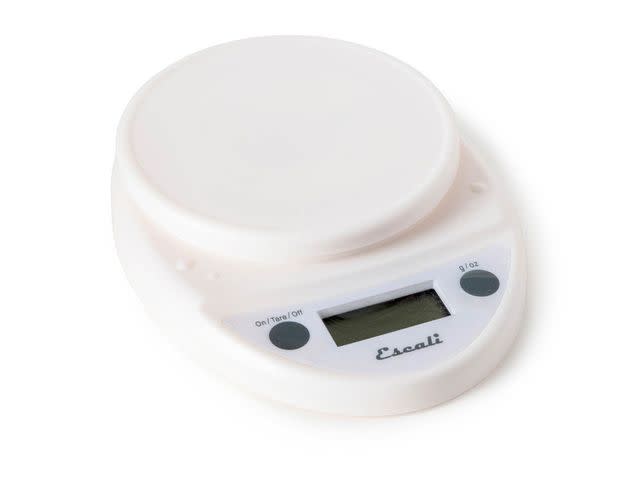
Serious Eats / Emily Dryden
The Competition
SIMPLETASTE Digital Kitchen Scale: This scale was accurate but timed out too quickly. Plus, the display wasn’t backlit, so it made it hard to read in certain lighting conditions.
My Weigh’s Kitchen Scale: This model was slower than the other scales we tested, taking longer to turn on. It also shut off after two minutes, which could set you back if you’re measuring several ingredients.
Ozeri Touch Professional Digital Kitchen Scale: This was one of the least accurate machines, off in almost all of its measurements. Because the scale's controls are built into the weighing platform, it was hard to measure any ingredients or tare a vessel because a slight touch to the scale would impact the weight.
Ozeri Pronto Digital Function Kitchen Scale: We did find this Ozeri model to be more accurate, but it was hard to clean, since the measuring plate wasn’t removable.
Escali Alimento Ultra Accurate Scale: This was the most expensive scale we tested and not as accurate as some of the other, more affordable options.
Etekcity Food Kitchen Scale: This scale was unable to measure smaller ingredients and failed at our first test of measuring a 2g penny. It was also inaccurate for larger measurements.
GreaterGoods Digital Food Kitchen Scale: This scale was accurate in most of our tests, but we found that weights varied if the vessel wasn’t exactly in the middle of the machine. What’s more, the lack of backlight made the measurements difficult to read depending on the kitchen lighting.
Cuisinart Balance Pro Digital Kitchen Scale and Cuisinart ProVantage Digital Kitchen Scale: These scales were among the most expensive and least accurate of the models we tested. They also began measuring at 5 grams, making them unsuitable for smaller measurements.
FAQs
What is the best kitchen scale for baking?
Both of our favorite kitchen scales, from OXO and Escali, are excellent for baking. The OXO does offer a pull-out display, though, which is particularly helpful for reading measurements when you have, say, a mixing bowl placed on the scale.
What units of measure does a kitchen scale have?
The best scales offer measurements in a variety of units. Our favorite kitchen scale, from OXO, has a unit conversion button that allows you to easily switch between grams, kilograms, ounces, and pounds.
How do you use a kitchen scale?
After turning the scale on, place your bowl or vessel on the scale and press the ‘tare’ button. On some scales, this is also the ‘on’ or ‘clear’ button. This returns the scale to 0, so you're only weighing the ingredients inside of the bowl. Then, slowly add whatever it is you need to measure, stopping when you reach the correct number.
What do you use a kitchen scale for?
A kitchen scale is useful for weighing all sorts of ingredients: be it flour, brown sugar, baking soda, salt, milk, or spices. It's also helpful for portioning ingredients, like chocolate chip cookies, portions of dough and meatballs, ensuring each one is the same size.
How do you calibrate a kitchen scale?
If you want to check to see if your scale is accurate, there's a simple test—and it involves pocket change. Find a standard U.S. nickel (the newer the better!), which should weigh exactly five grams. Turn on your scale, make sure it reads ‘0,' then place the nickel on the scale. If it weighs five grams, then congratulations! Your scale is accurate. If not, check the scale’s instruction manual to see if it has a calibration setting or function. If it doesn’t, you may need to return it or contact the manufacturer.
Can you use a kitchen scale to weigh packages?
You could... if the package is light enough. Our favorite scale from OXO goes up to 11 pounds. It won't record anything beyond that.
Why should you measure by weight?
Weighing out ingredients for a recipe is more accurate than measuring by volume. A few grams more of an ingredient, especially when baking, can make for different results. Using a kitchen scale to weigh ingredients just eliminates any potential human error.
Read More:This Is the Best Stand Mixer You Can Buy

